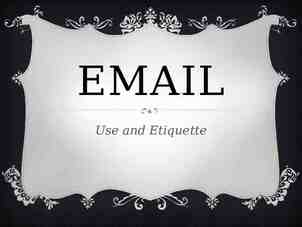Fundamentals of Marketing Prof. Amad Un Nasar
32 Slides763.12 KB
Fundamentals of Marketing Prof. Amad Un Nasar
Chapter No 1
Marketing Marketing is managing profitable customer relationships
Marketing Defined Old Concept Telling and Selling New Concept Satisfying Customer Needs HOW? Understand Consumer Needs Develop product having superior values Price, Promote and Distribute them Effectively
The process by which companies create value for customers and build strong customer relationships in order to capture value from customers in return.
Marketing Process
1. Understanding the Marketplace and Customer Needs a) Needs, Wants and Demands b) Market offerings (Product, Services and Experiences) c) Value and Satisfaction d) Exchange and relationship e) Markets
a. Needs, Wants and Demands Need: – states of felt deprivation Physical, social, Individual Need for knowledge and expression. I m Hungry Wants: – The form human needs take as they are shaped by culture and individual personality. I need Zinger Demands: – Human wants that are backed by buying power. I need Mac Zinger Spend time with customers P&G spends time with customers Southwest Airlines Executives Harley- Davidson’s
Market Offerings—Products, Services, and Experiences Needs wants and Demands fulfills through Market Offerings Product Services Others (Persons, Places, Organization, Information and Ideas) Marketing Myopia : . – They are so taken with their products that they focus only on existing wants and lose sight of underlying customer needs.
c. Customer Value and Satisfaction Consumers usually face a broad array of products and services that might satisfy a given need. How do they choose among these many market offerings? Customers form expectations about the value and satisfaction that various market offerings will deliver and buy accordingly. Marketers must be careful to set the right level of expectations. If set Expectation too LOW If set Expectation Too High
d. Exchanges and Relationships Marketing is a Exchange Process Exchange: The act of obtaining a desired object from someone by offering something in return. Marketing consists of actions taken to build and maintain desirable exchange relationships. Not only to attract but retain and grow
e. Markets The set of all actual and potential buyers of a product or service.
DESIGNING A CUSTOMERDRIVEN MARKETING STRATEGY
Designing a Customer-Driven Marketing Strategy Marketing management: The art and science of choosing target markets and building profitable relationships with them. The marketing manager’s aim is to find, attract, keep, and grow target customers by creating, delivering, and communicating superior customer value.
a. Selecting Market To Serve Market Segmentation Target Marketing Not to maximize your customer Better Serve
b. Set Value Proposition value proposition: is the set of benefits or values it promises to deliver to consumers to satisfy their needs. Why I buy this brand?
c. Marketing Management Orientation Production Concept Product Concept Selling Concept Marketing Concept (Customer Driven and Customer Driving marketing) Make and Sell (Inside out) Sense and Respond (Outside in)
Societal Marketing Concept (sustainable marketing) questions whether the pure marketing concept overlooks possible conflicts between consumer short-run wants and consumer long-run welfare. deliver value to customers in a way that maintains or improves both the consumer’s and society’s wellbeing. Social responsibility “isn’t just good for the planet,” says the company. “It’s good for business
PREPARING AN INTEGRATED MARKETING PLANS AND PROGRAMS
Preparing an integrated Marketing Plans and Programs The marketing program builds customer relationships by transforming the marketing strategy into action. It consists of the firm’s marketing mix, the set of marketing tools the firm uses to implement its marketing strategy. Product Price Place Promotion
BUILDING CUSTOMER RELATIONSHIP
Building Customer Relationship Customer Relationship Management Some marketers define it narrowly as a customer data management activity (a practice called CRM). managing detailed information about individual customers and carefully managing customer “touchpoints” to maximize customer loyalty. “overall process of building and maintaining profitable customer relationships by delivering superior customer value and satisfaction.”
Relationship Building Blocks Customer Value and Satisfaction Consumer Perceive Value (cost benefits analysis) – value might mean paying more to get more Consumer Satisfaction (depends on perceive performance) – Expectation and Performance – Not Loyal but “customer evangelists” – Ritz Carlton Hotel (Laundry) (Picture Frame) (90% repeat Purchase and 95% Stisfied)
Customer Satisfaction Levels Built relationship on target market level LOW Margin Customer Basic Relationship Relationship through Brand Building Advertising, Public Relationship and Domain Names full partnerships with key customers. How Stronger Bond With Customers? Frequency marketing programs Club Marketing Programs
THE CHANGING NATURE OF CUSTOMER RELATIONSHIPS
The Changing Nature of Customer Relationships Relating with More Carefully Selected Customers Few firms today still practice true mass marketing Target fewer, more profitable customers. customer profitability analysis. “Some are more costly to serve than to lose.” Screen out than progress otherwise What companies do with unprofitable customers? Relating More Deeply and Interactively Two-Way Customer Relationships (e-mail, Web sites, blogs, cell phones, and video sharing to online communities and social networks, such as Facebook, YouTube, and Twitter.) customer-managed relationships. Marketing relationships in which customers, empowered by today’s new digital technologies, interact with companies and with each other to shape their relationships with brands. online social networks.
Consumer-Generated Marketing. – Brand exchanges created by consumers invited and uninvited— by which consumers are playing an increasing role in shaping their own brand experiences and those of other consumers. – companies are inviting consumers to play a more active role in shaping products and brand messages. Partner Relationship Management – Working closely with partners in other company departments and outside the company to jointly bring greater value to customers. – Inside Company – Outside Company (Supply chain and Supply chain management)
(5) Capturing Value from Customers Customer Loyalty and retention in an improved economy, 55 percent of consumers say they would rather get the best price than the best brand. It’s five times cheaper to keep an old customer than acquire a new one. Customer lifetime value Loosing one customer does not mean loosing one sale The value of the entire stream of purchases that the customer would make over a lifetime of patronage. Growing Share of Customer good customer relationship management can help marketers increase their share of customer (the share they get of the customer’s purchasing in their product categories.). Cross selling and up selling
Building Customer Equity Customer equity Total combined customer lifetime values of all of the company’s current and potential customers. the more loyal the firm’s profitable customers, the higher its customer equity. Cadillac defined American luxury Cadillac’s share of the luxury car market reached a whopping 51 percent in 1976. Rosy Future but Cadillac customers were getting older (average age 60) and average customer lifetime value was falling. Many Cadillac buyers were on their last cars.
Building the Right Relationships with the Right Customers But not all customers, not even all loyal customers, some loyal customers can be unprofitable





































